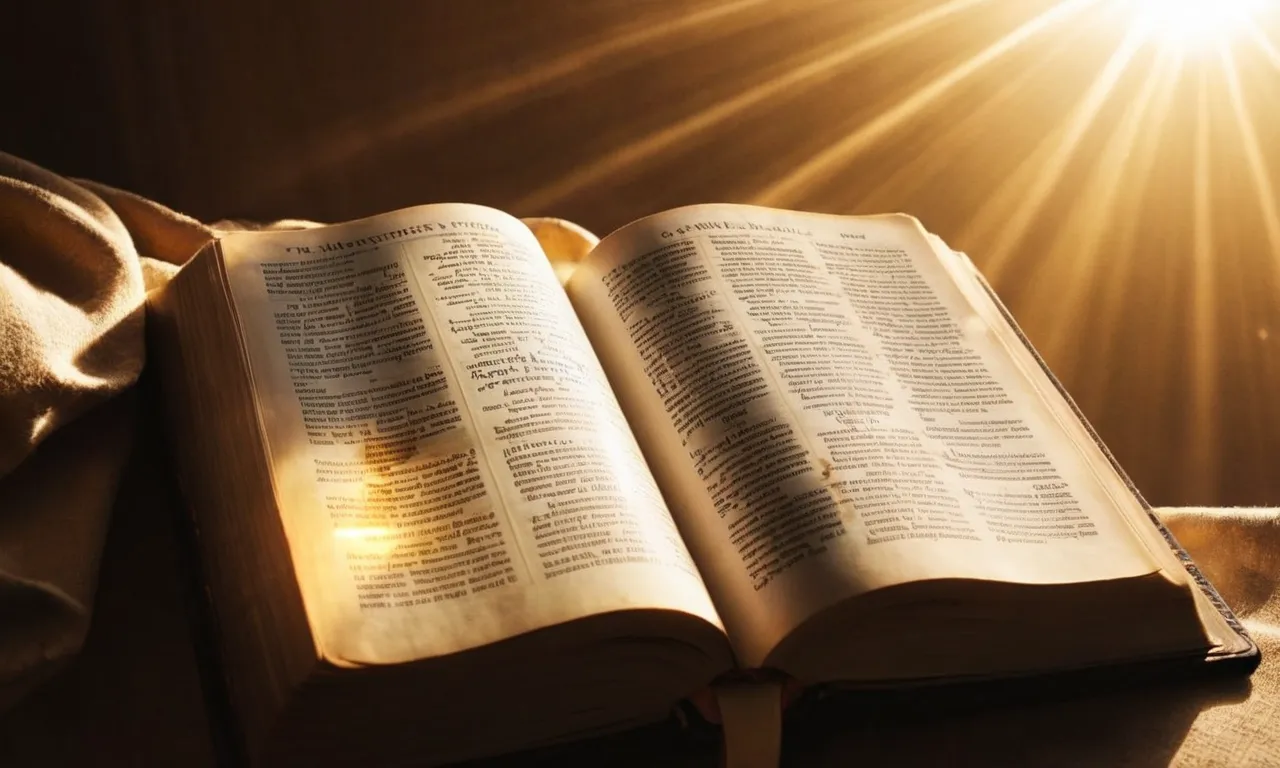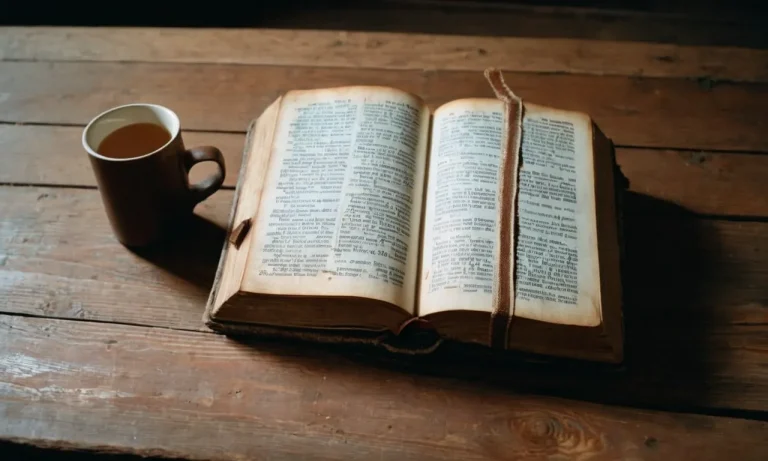How Many Major Prophets Are There In The Bible?
The prophets in the Bible played a vital role in God’s plan of salvation. Their divinely inspired messages called God’s people to repentance and pointed ahead to the coming of the Messiah. But among these prophetic voices, a select few stand out as the ‘major prophets’.
If you’re short on time, here’s a quick answer to your question: there are 5 major prophets in the Bible – Isaiah, Jeremiah, Lamentations, Ezekiel and Daniel.
In this comprehensive article, we will take a deep dive into these 5 books and their authors – the major prophets. We will look at when they prophesied, the key themes in their messages, and the lasting impact their prophecies have made.
Understanding the Role of a Prophet
God’s Messengers
In the Bible, prophets served as God’s messengers, speaking on His behalf and conveying His words to the people. They acted as intermediaries between God and humans, calling people to repentance, warning them of coming judgment, and revealing God’s plans and purposes.
As mouthpieces for the divine, prophets occupied a unique position, spending time in God’s presence to receive revelation and instructions to deliver.
Some well-known prophets in the Bible include Moses, Samuel, Elijah, Elisha, Isaiah, Jeremiah, Ezekiel, and Daniel in the Old Testament, along with John the Baptist and Agabus in the New Testament. Their primary role was to speak truth that originated from God, not themselves.
As conduits of divine revelation, they faithfully transmitted God’s unfiltered words.
Forthtelling and Foretelling
The prophets served two key functions – forthtelling and foretelling. Forthtelling involved proclaiming God’s truth and calling God’s people to obey and align with His will. Often this meant confronting sin, idolatry, and social injustice.
Foretelling involved predicting future events under the inspiration of the Holy Spirit. Through dreams, visions, and other revelations, prophets disclosed things to come – some in the near future, others in the distant future.
While foretelling grabbed attention because of the supernatural element, the majority of a prophet’s work focused on forthtelling – revealing God’s heart, will, and Assessment of the present circumstances. Their messages provided spiritual insights and perspectives that the people needed to hear.
Forthtelling laid the foundation for repentance and spiritual renewal.
Speaking Truth to Power
The prophets sometimes functioned as truth-tellers to power, rebuking kings and civil leaders for their ungodly actions. For example, the prophet Nathan confronted King David about his adultery and murder (2 Samuel 12), and Elijah challenged King Ahab over his idolatry and corruption (1 Kings 18).
Jesus called King Herod “that fox” for his immorality and injustice (Luke 13:32).
These courageous stands often incited persecution and hostility from those in authority. But the prophets understood their accountability was to God, not man. Their commitment to truth arose from an inner conviction that obeying God took priority over garnering human approval.
This “speaking truth to power”流function serves as a hallmark of authentic, biblical prophecy centered on moral accountability and righteous living.
Isaiah – Prophet of Judgment and Salvation
Background and Timeline
Isaiah was one of the most influential Old Testament prophets. He began his prophetic ministry around 740 BC during the reigns of Kings Uzziah, Jotham, Ahaz and Hezekiah over Judah. This was a tumultuous time as the Assyrian empire was expanding and threatening the kingdom of Judah.
Isaiah preached in Jerusalem, acting as an advisor to the royal court and trying to convey messages from God to the leadership and people of Judah.
Isaiah came from a family of some status as his father Amoz seems to have had access to the king (Isaiah 7-8). Tradition holds that Isaiah was martyred by being sawed in two during the reign of King Manasseh.
The prophet Jeremiah and the author of the New Testament book of Hebrews affirms parts of Isaiah’s legacy (Hebrews 11:37, Jeremiah 26:20). Isaiah’s ministry spanned over 40 turbulent years as he witnessed the downfall of the northern kingdom of Israel to Assyria followed by the devastation of Judah by the Babylonians over a century later.
Major Themes
A major theme of the book of Isaiah is judgment and punishment. Isaiah chastises both Israel and Judah for their pride, lack of faith in God, idolatry, greed, and mistreatment of the poor. He warns that if they do not repent and turn from their evil ways, they will face invasion, siege, and ultimately exile.
Tied to this theme of judgment is also the promise of future restoration and salvation. While punishment is inevitable in the short term, Isaiah provides a message of hope – God will restore the remnant of Israel and Judah and return them to the land.
There will be a messianic king to lead the people and usher in an era of righteousness and peace.
Some of the other major themes covered in Isaiah include trusting in the sovereignty of God rather than earthly rulers or idols, social injustice and care for the disadvantaged, the folly of relying on foreign military powers for deliverance, pride before the fall, the future inclusion of Gentiles into God’s plan, and the Suffering Servant.
Isaiah utilizes a distinctive writing style shifting between poetic verses and powerful visions.
Key Prophecies and Their Fulfillment
Isaiah accurately prophesied many future events including:
- The coming Babylonian captivity of Judah (Isaiah 39)
- Cyrus the Persian allowing the Jews to return to Israel (Isaiah 44-45)
- The later ministry of John the Baptist (Isaiah 40)
- The virgin birth of Jesus the Messiah (Isaiah 7:14)
In astonishing detail in Isaiah 53, there is a portrayal of the rejected Suffering Servant whose death would atone for the sins of humanity. This was remarkably fulfilled in the crucifixion of Jesus Christ.
The book of Isaiah has sometimes been called the “Fifth Gospel” given how much it focuses on the coming Messiah and His sacrifice for sins.
Jeremiah – The Weeping Prophet
Background and Timeline
Jeremiah was one of the major prophets in the Old Testament of the Bible. He lived and prophesied during the late 7th and early 6th centuries BC, around the time of the fall of Jerusalem and the destruction of Solomon’s Temple in 587 BC.
Jeremiah came from a priestly family in the village of Anathoth near Jerusalem. He began his prophetic ministry as a young man sometime around 626 BC during the reign of King Josiah. Jeremiah continued prophesying throughout the reigns of the last five kings of Judah right up until the fall of Jerusalem.
Jeremiah’s ministry lasted for more than 40 tumultuous years as he witnessed the progressive moral and spiritual decline of the Jewish nation. He cried out against rampant idolatry, social injustice, religious hypocrisy and moral decay among the people of Judah.
Jeremiah suffered greatly as his prophecies were largely ignored and rejected. He was persecuted and imprisoned by the authorities. Still, he faithfully declared God’s word to deaf ears and hard hearts.
Key events during Jeremiah’s ministry include:
- 626 BC – Jeremiah’s call to be a prophet
- 622 BC – Discovery of the Book of the Law during Josiah’s reign
- 609 BC – Death of Josiah, start of rapid moral decline in Judah
- 605 BC – Exile of Jewish nobles to Babylon, including Daniel
- 597 BC – First siege of Jerusalem and exile to Babylon
- 588-586 BC – Destruction of Jerusalem and the Temple by Babylon
Major Themes
Some of the major themes in the Book of Jeremiah include:
- Judgment for sin – Jeremiah proclaimed that God was judging Judah for their idolatry and wickedness by sending calamity and exile through Babylon.
- Calls to repentance – The prophet urged the people to repent and turn back to God to avoid further judgment.
- Lament over Judah – Jeremiah expressed deep anguish and weeping over the coming devastation of Jerusalem and exile of the Jews.
- False prophets – Jeremiah condemned the lies and false assurances of the false prophets who said peace was coming despite Judah’s sin.
- A new covenant – God would establish a new covenant written on the hearts of His people, not just external law.
Jeremiah’s somber message exposed the nation’s sins, warned of imminent judgment, and called for true repentance. His dire predictions of disaster earned him the title “the weeping prophet.”
Key Prophecies and Their Impact
Some of Jeremiah’s most important prophecies included:
- The imminent fall and destruction of Jerusalem – Tragically fulfilled in 587 BC by the Babylonian army.
- Exile in Babylon for 70 years – Came to pass from 605 to 536 BC before the Jews could return.
- God’s judgment on foreign nations – Against Egypt, Philistia, Moab, Babylon, and others; largely fulfilled.
- The return of the exiles and restoration – Beginning with Zerubbabel’s return to rebuild the Temple.
- The coming day of God’s wrath – Pointing to future judgment but also salvation by grace.
- The new covenant through Christ – Fulfilled 600 years later through Jesus’ life, death, and resurrection.
Jeremiah’s prophecies had an immense impact in his day and beyond. He powerfully confronted sin while also proclaiming future hope. Centuries after Jeremiah’s time, his divine predictions strongly influenced many to accept Jesus as the promised Messiah and Savior.
Lamentations – Jeremiah’s Expression of Grief
Background
The book of Lamentations is traditionally attributed to the prophet Jeremiah and was likely written shortly after the fall of Jerusalem in 586 BC. As the capital city was sieged and destroyed by the Babylonians, Jeremiah watched in horror as the temple was burned, the walls were torn down, and the people were taken away into exile.
Understandably, Jeremiah was absolutely devastated by these events.
In Lamentations, Jeremiah mourns the tremendous loss and pours out his grief over Jerusalem’s destruction. The poems contained in this book let us listen in as Jeremiah anguishes over what has happened to his people and his city.
This profound expression of sadness allows us insight into how heavily the events weighed on Jeremiah’s heart.
Overview of the Book’s Contents
The book of Lamentations contains five poetic laments, each functioning as a separate chapter. Though brief, these poetic dirges powerfully communicate Jeremiah’s profound grief. Here is a brief overview of each lament:
- Chapter 1 – Jeremiah mourns over Jerusalem’s utter desolation following the siege and destruction by the Babylonians.
- Chapter 2 – Jeremiah continues to grieve and accuse over Jerusalem’s fall to the enemy.
- Chapter 3 – Jeremiah focuses on his own pain and suffering yet affirms hope in God’s compassion.
- Chapter 4 – Jeremiah vividly describes the starvation and desperation of Jerusalem’s people during the siege.
- Chapter 5 – Jeremiah offers one final lament and plea for God to restore and renew His people.
These gut-wrenching poems poignantly express the enormous grief, anger, confusion, and despair Jeremiah felt in the aftermath of Jerusalem’s shocking defeat. Through these laments, Jeremiah gives voice to the pain of himself, Jerusalem, and the exiled people.
Theological Significance
Though Lamentations is heavy with grief, it also contains theological truths and hope. Even in the midst of agonizing over Jerusalem’s ruin, Jeremiah confesses his continued trust and hope in God. For example, Jeremiah declares:
“Because of the Lord’s great love we are not consumed, for his compassions never fail. They are new every morning; great is your faithfulness.” (Lamentations 3:22-23)
Despite the horrific circumstances, Jeremiah affirms God’s everlasting love, mercy, and faithfulness. While God did judge His people for their sin, His loyal compassion remains steadfast. So even in the ashes of destruction, Jeremiah clings to the eternal truth of God’s goodness.
Lamentations reminds us that it’s acceptable to grieve deeply and question God in suffering. But ultimately, we must trust God’s wisdom and character, even when we don’t understand what He is doing. No matter how hopeless things may seem, God remains sovereign, loving, and faithful.
Ezekiel – Prophet of Judgment and Restoration
Background and Timeline
Ezekiel was a priest who lived during the time of the Babylonian exile in the 6th century BC. He began his prophetic ministry around 593 BC while living among the Jewish exiles in Babylon. Ezekiel continued prophesying for at least 22 years, probably until around 571 BC.
Some key events during Ezekiel’s ministry include:
- 597 BC – First wave of exiles from Judah arrive in Babylon after Jerusalem is conquered by King Nebuchadnezzar.
- 586 BC – Destruction of Jerusalem and the temple by the Babylonians after a rebellion.
- 582 BC – Gedaliah, governor of Judah appointed by Babylon, assassinated. More Jewish nobles flee to Egypt.
Ezekiel lived through incredibly difficult times for the Jewish people. But his prophecies offered a message of hope – that God would restore and redeem His people despite the tragedy of exile.
Major Themes
Some of the major themes in the book of Ezekiel include:
- God’s judgment on Israel’s sin – Ezekiel confronted the people’s idolatry and rebelliousness. He warned that judgment was coming through the Babylonian conquest.
- Individual responsibility – Ezekiel challenged the idea that children inherit their parent’s guilt. He taught that each person is responsible for their own sin.
- God’s sovereignty – Despite tragedy and exile, God remained all-powerful and in control of history. Ezekiel assured that no nation or ruler thwarts God’s plans.
- Future restoration – After judgment, Ezekiel prophesied Israel’s restoration to the land and spiritual renewal through God’s grace.
Key Visions and Their Meaning
Ezekiel records some striking symbolic visions that vividly communicated coming judgment and restoration:
- Vision of God’s glory – Ezekiel sees blazing throne-chariot, emphasizing God’s transcendence and authority over all creation.
- Scroll of lamentation – Ezekiel eats a scroll lamenting Judah’s sin, symbolizing him internalizing God’s message to deliver.
- Valley of dry bones – Ezekiel sees scattered bones coming to life, picturing Israel’s promised national restoration.
- New temple – Detailed vision of idealized temple represents God’s presence returning to a renewed Israel.
These mysterious visions grab attention and communicate essential theological themes – God’s supreme glory, the certainty of prophesied judgment and restoration, and the need for spiritual renewal among God’s people.
Ezekiel creatively uses symbolic imagery to convey God’s word with power and memorability.
Daniel – Prophet of the End Times
Background and Timeline
Daniel was an Israelite prophet who lived during the Babylonian exile in the 6th century BC. He was of noble birth and was taken captive by King Nebuchadnezzar of Babylon when Jerusalem was conquered in 605 BC.
Daniel served in the royal court and had visions and dreams that revealed future events and end times prophecies. Some key events in Daniel’s life include:
- 605 BC – Taken captive to Babylon
- 603 BC – Refused to eat non-kosher food, faith tested in the lion’s den
- 553 BC – Vision of four beasts representing four kingdoms
- 539 BC – Babylon conquered by the Medes and Persians
- 537 BC – Visions of ram and goat representing Persia and Greece
- 534 BC – Vision of 70 weeks prophecy
Daniel lived to see the fall of Babylon and return of some exiles to Jerusalem. His prophecies reached far into the future, predicting the coming of the Messiah and end time events. He was a man of great faith, uncompromising in his devotion to God.
Key Visions and Dreams
Some of Daniel’s most significant prophecies came in the form of symbolic dreams and visions. These include:
- The Four Beasts (Daniel 7) – Daniel saw four beasts representing four successive kingdoms – Babylon, Medo-Persia, Greece, and Rome. The fourth beast was especially ferocious, with 10 horns.
- The Ram and Goat (Daniel 8) – A two-horned ram represented the Medo-Persian empire, defeated by a goat representing Greece and its first king, Alexander the Great.
- The Seventy Weeks (Daniel 9) – Daniel received a complex vision of 70 “weeks” predicting the coming of the Messiah and the rebuilding of Jerusalem.
- Kings of the North and South (Daniel 11) – This prophecy gave an amazingly accurate preview of conflicts between the Seleucid and Ptolemaic dynasties down to their individual kings.
These symbolic visions establish Daniel’s book as truly prophetic in nature, predicting the course of history centuries in advance with stunning accuracy. They form the backbone of apocalyptic prophecy in the Bible.
Prophecies Fulfilled and Yet to be Fulfilled
Daniel contains prophecies that have already come to pass with perfect accuracy, giving confidence that the remaining unfulfilled prophecies will also occur. Among those already fulfilled:
- The rise and fall of Babylon, Medo-Persia, Greece, and Rome (Daniel 2, 7-8)
- Cyrus the Persian conquering Babylon (Isaiah 44-45)
- Alexander the Great’s meteoric conquests (Daniel 8)
- The intertestamental conflicts of Seleucids and Ptolemies (Daniel 11)
- The coming of Jesus Christ as Messiah and His death (Daniel 9)
Yet to be fulfilled prophecies include the coming Tribulation period, the Antichrist’s global kingdom, Christ’s Second Coming, the resurrection of the dead, and the establishment of Christ’s millennial kingdom on earth (Daniel 7, 9, 12).
As history has proven Daniel’s prophecies trustworthy, we can await their final fulfillment with expectancy.
Conclusion
The major prophets – Isaiah, Jeremiah, Lamentations, Ezekiel and Daniel – spoke difficult truths to God’s people. They warned of impending judgment if the people did not repent. And they looked ahead to a time of future blessing when God would heal and restore.
As we study these 5 prophetic books that have been preserved for us in Scripture, we can see glimpses of Jesus woven throughout their messages. We also gain perspective on God’s unrelenting commitment to redeem this broken world He created and to restore us to relationship with Himself through Christ.








